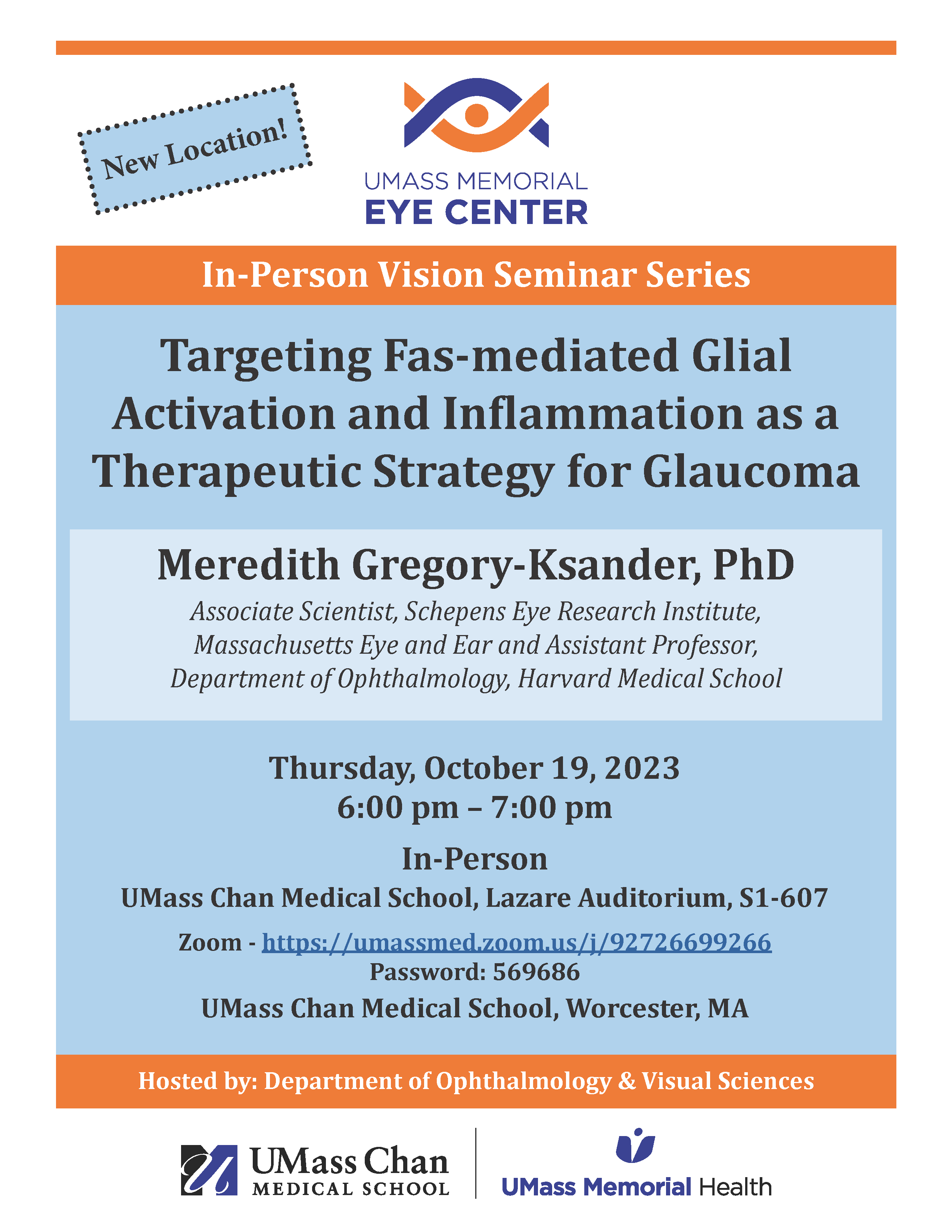Targeting Fas-mediated Glial Activation and Inflammation as a Therapeutic Strategy for Glaucoma
Date Posted: Thursday, October 05, 2023Meredith Gregory-Ksander, PhD, Assistant Scientist, The Schepens Eye Research Institute, and Assistant Professor, Department of Ophthalmology, Harvard Medical School. Dr. Gregory-Ksander received her Ph.D. in Cell Biology, Neurobiology, and Anatomy from Loyola University of Chicago in 1999. Dr. Gregory-Ksander joined the faculty at Schepens Eye Research Institute, Department of Ophthalmology, Harvard Medical School in 2004.
Research Focus: With an expertise in cell biology and immunology, Dr. Gregory-Ksander has had a longstanding interest in how age-related changes in immune privilege and subsequent inflammation contributes to the development of glaucoma. Her laboratory uses experimental models of glaucoma to study glial activation and inflammation in the development and progression of disease. Her work has led to the identification of specific inflammatory pathways, including the Fas-Fas ligand pathway, NLRP3 inflammasome pathway, and the alternative complement pathway, that when targeted have proven to be highly neuroprotective in animal models of glaucoma. Dr. Gregory-Ksander’s most recent work has taken her from “preservation” of vison to “restoration” of vision using two novel approaches: (i) epigenetic reprogramming of sick and/or dying RGCs, and (ii) “resetting” microglia homeostasis and restoring the neuroprotective environment of the eye through AAV-mediated gene delivery of soluble FasL.
Her work has been published in top tier journals including Nature, Cell, and Journal of Experimental Medicine and has been recognized by both the Research to Prevent Blindness Foundation and Bright Focus foundation, with the Sybil B. Harrington Special Scholar Award, The Thomas R. Lee Award for Glaucoma, and The Douglas H. Johnson Award for Glaucoma. Dr. Gregory-Ksander is also a co-inventor on three patent applications and serves on the Scientific Advisory Board of ONL Therapeutics.
Summary: Glaucoma is a progressive eye disease that ultimately leads to the death of retinal ganglion cells (RGC) and loss of vision. While the exact pathobiology is unclear, several studies link the progressive loss of RGCs with glial activation and neuroinflammation. In 2003, our lab in collaboration with Simon John and Wayne Streilein, demonstrated in the DBA/2J spontaneous mouse model of glaucoma, that (i) ocular immune privilege is lost prior to the development of glaucoma, and (ii) the development of glaucoma coincided with increased expression of Fas ligand (FasL) in the eye. We went on to demonstrate that in the normal eye, FasL is primarily cleaved and expressed as a soluble protein (sFasL), essential for maintaining immune privilege and inhibiting inflammation within the eye. However, in both spontaneous and inducible models of glaucoma, we demonstrate that Fas activation is a critical mediator of neuroinflammation in the retina and optic nerve head and is associated with a switch from the soluble to the membrane-bound form of FasL (mFasL). While mFasL is best known for inducing apoptosis of Fas receptor expressing cells, using a novel transgenic mouse we demonstrate that Fas-mediated inflammation, but not apoptosis is the driving force in the development of glaucoma. Specifically, increased expression of mFasL and the development of glaucoma coincides with microglia activation and induction of pro-inflammatory mediators. However, restoring sFasL expression, through an AAV-mediated gene delivery approach, “resets” microglia homeostasis, shuts down neurodestructive inflammation, and halts disease progression. Together, these data support the hypothesis that sFasL is essential in maintaining retinal microglia homeostasis and restoration of the sFasL:mFasL balance in glaucomatous eyes promotes RGC survival, through inhibition of microglia activation and restoration of the neuroprotective environment of the eye. Further supporting this hypothesis, our most recent work demonstrates that treatment with AAV2.sFasL after glaucoma injury can “reset” microglia homeostasis and restore function of sick and/or dying RGCs. Based on our work, we believe that “resetting” microglia homeostasis and restoring the neuroprotective environment of the eye is essential for not only preventing further disease progression and rescuing and restoring function of sick/dying RGCs, but also for setting the stage for RGC transplantation and other treatments designed to stimulate regeneration of RGC axons and restore vision in patients with advanced glaucoma.
.
